NASA's Voyager probes have been traveling through space for nearly 46 years. Here are 18 groundbreaking photos from their incredible mission.
- Nearly 46 years after their launch, Voyager 1 and 2 will likely soon reach the end of their scientific mission .
- NASA recently lost contact with Voyager 2 after sending it a bad command by mistake.
- Here are 18 pictures the probes took over the course of their forty-plus-year journey.

The Voyager probes are pioneers of science, making it farther into space than any other manufactured object. But now, they face a terminal problem: their power is running out.
The twin probes were originally sent on a four-year mission to tour the solar system, but they exceeded all expectations and are still going nearly 46 years later. That makes them NASA's longest-lived mission.
Scientists are now doing their best to keep the probes going for as long as possible. They recently found a clever hack to extend Voyager 2's life for another three years and plan to do the same with Voyager 1.
But these are old machines and NASA is constantly scrambling to fix mistakes. Last year, Voyager 1 started sending garbled data from the outside of the solar system. NASA ultimately figured out one of its computers had gone dead.
Voyager 2 is now in limbo , as the agency revealed Friday it had lost contact with the probe when someone sent a wrong command. It could be the end of Voyager 2's mission if NASA can't fix the mistake, which the agency probably won't be able to do before October.
As the probes are nearing the end of their scientific mission, here are 18 images from Voyager that changed science.

The Voyager probes were designed to visit Jupiter and Saturn.
The Voyager mission included two probes — Voyager 1 and Voyager 2 — which NASA launched in 1977 within a few months of each other.
NASA took advantage of a rare planet alignment to turbocharge their journeys into space.
NASA originally built the probes to last five years, but they have exceeded that lifespan many times .
As of August 20 and September 5, 2023, Voyager 2 and Voyager 1 will have been traveling for 46 years, respectively.
This is what Voyager 1 saw on its approach to Jupiter.
Voyager 1 and Voyager 2 reached Jupiter in 1979.
As they flew by the planet, they took about 50,000 pictures of Jupiter. These blew away scientists, as the quality of the pictures was much better than those taken from Earth, according to NASA.
These snaps taught scientists important facts about the planet's atmosphere, magnetic forces, and geology that would have been difficult to decipher otherwise.
The probes discovered two new moons orbiting Jupiter: Thebe and Metis.
They also spotted a thin ring around Jupiter.
The probe captured this picture as it was looking back at the planet backlit by the Sun.
Voyager 1 discovered volcanoes at the surface of Io, one of Jupiter's moons.
Next stop: Saturn.
In 1980 and 1981, the probes reached Saturn . The flyby gave scientists unprecedented insight into the planet's ring structure, atmosphere, and moons.
Voyager snapped Saturn's rings in more detail than ever before.
And showed every secret that Enceladus, Saturn's moon, had to offer.
Saturn, snapped as the probe flew away, was shown in a new light.
By 1986, Voyager 2 had made it to Uranus.
By 1986, Voyager 1 has finished its grand tour of the solar system, and few out towards space. But Voyager 2 kept on its exploring our nearest planets, passing 50,600 miles away from Uranus in January 1986.
Voyager 2 discovered two extra rings around Uranus , revealing the planet had at least 11, not 9.
Voyager 2 also spotted 11 previously unseen moons around Uranus.
Here is a picture of Miranda, Uranus's sixth-biggest moon.
Voyager 2 was the first spacecraft to observe Neptune from a close distance.
In 1989, 12 years after its launch, Voyager 2 passed within 3,000 miles of Neptune.
Here's Nepture taken by Voyager 2, in all its blue glory.
Voyager 2 took this unflattering pic of Triton's rough face.
It captured Triton, Neptune's moon in unprecedented detail.
And snapped Triton's southern hemisphere.
As it flew by, Voyager 2 uncovered Neptune's rings.
As its parting gift, Voyager 2 took this beautiful picture of light grazing Neptune's south pole.
This is Voyager 2's last picture. Since it wouldn't come across another planet on its ongoing journey, NASA switched off its cameras after its flyby of Neptune to conserve energy for other instruments.
Voyager 1 had one last trick up its sleeve.
As its last photographic hurrah in 1990, Voyager 1 took 60 images of the solar system from 4 billion miles away.
It gave us the Earth's longest selfie, dubbed the "pale blue dot."
This remains the longest-range selfie: a portrait of the Earth taken by a human-made probe from 4 billion miles away.
After this picture, NASA switched off Voyager 1's cameras to save energy. NASA could switch the probes' cameras back on , but it is not a priority for the mission.
Beyond the solar system
Though the probes are no longer sending pictures, they haven't stopped sending crucial information about space.
In 2012, Voyager 1 became the first human-made instrument to cross into interstellar space by crossing the boundary between our solar system and the rest of the universe, called the heliopause.
Voyager 2 was second, crossing that threshold in 2018 . The probe revealed that there was yet another layer outside of our heliosphere.
The probes keep sending back measurements from interstellar space, like weird hums likely coming from vibrations made by neighboring stars.
Even after their instruments are switched off, the probes' mission continues.
NASA is planning to switch more of the probes' instruments in the hope of extending their life to the 2030s.
But even after all their instruments become quiet, their mission will carry on. As they drift off, they will still be carrying a golden record that carries crucial information about humanity. If intelligent extraterrestrial life exists, they could use that information to reach out to us.
This article was originally published on June 6, 2022, and is being updated with the latest developments about Voyager 1 and 2.
- Main content
Voyager Image Gallery
45 years of voyager i and ii.
Launched in 1977, NASA’s twin Voyager spacecraft inspired the world with pioneering visits to Jupiter, Saturn, Uranus, and Neptune. Their journey continues 45 years later as both probes explore interstellar space, the region outside the protective heliosphere created by our Sun. Researchers – some younger than the spacecraft – are now using Voyager data to solve mysteries of our solar system and beyond.

This archival photo shows engineers working on vibration acoustics and pyro shock testing of NASA’s Voyager on Nov. 18, 1976.

NASA’s Voyager 1 acquired this image of a volcanic explosion on Io on March 4, 1979, about 11 hours before the spacecraft’s closest approach to the moon of Jupiter.

This updated version of the iconic "Pale Blue Dot" image taken by the Voyager 1 spacecraft uses modern image-processing software and techniques to revisit the well-known Voyager view while attempting to respect the original data and intent of those who planned the images.

This illustrated graphic was made to mark Voyager 1’s entry into interstellar space in 2012. It puts solar system distances in perspective, with the scale bar in astronomical units and each set distance beyond 1 AU (the average distance between the Sun and Earth) representing 10 times the previous distance.

This graphic highlights some of the Voyager mission’s key accomplishments. Credit: NASA/JPL-Caltech Full image details

This graphic provides some of the mission’s key statistics from 2018, when NASA’s Voyager 2 probe exited the heliosphere. Credit: NASA/JPL-Caltech Full image details
- Become A Member
- Gift Membership
- Kids Membership
- Other Ways to Give
- Explore Worlds
- Defend Earth
How We Work
- Education & Public Outreach
- Space Policy & Advocacy
- Science & Technology
- Global Collaboration
Our Results
Learn how our members and community are changing the worlds.
Our citizen-funded spacecraft successfully demonstrated solar sailing for CubeSats.
Space Topics
- Planets & Other Worlds
- Space Missions
- Space Policy
- Planetary Radio
- Space Images
The Planetary Report
The eclipse issue.
Science and splendor under the shadow.
Get Involved
Membership programs for explorers of all ages.
Get updates and weekly tools to learn, share, and advocate for space exploration.
Volunteer as a space advocate.
Support Our Mission
- Renew Membership
- Society Projects

The Planetary Fund
Accelerate progress in our three core enterprises — Explore Worlds, Find Life, and Defend Earth. You can support the entire fund, or designate a core enterprise of your choice.
- Strategic Framework
- News & Press
The Planetary Society
Know the cosmos and our place within it.
Our Mission
Empowering the world's citizens to advance space science and exploration.
- Explore Space
- Take Action
- Member Community
- Account Center
- “Exploration is in our nature.” - Carl Sagan
Rae Paoletta • Mar 03, 2022
The best space pictures from the Voyager 1 and 2 missions
Launched in 1977, NASA’s Voyager 1 and 2 missions provided an unprecedented glimpse into the outer solar system — a liminal space once left largely to the imagination. The spacecraft provided views of worlds we’d never seen before, and in some cases, haven’t seen much of since.
The Voyager probes were launched about two weeks apart and had different trajectories, like two tour guides at the same museum. Only Voyager 2 visited the ice giants — Uranus and Neptune — for example.
The Voyagers hold a unique position in the pantheon of space history because they’re still making it; even right now, Voyagers 1 and 2 are the only functioning spacecraft in interstellar space. Both hold a Golden Record that contains sights and sounds of Earth in case alien life were to find one of the spacecraft.
As the Voyager missions voyage on, it’s good to look back at how they captured our solar system before leaving it.
This content is hosted by a third party (youtube.com), which uses marketing cookies. Please accept marketing cookies to watch this video.
Your support powers our mission to explore worlds, find life, and defend Earth. Give today!
For full functionality of this site it is necessary to enable JavaScript. Here are instructions on how to enable JavaScript in your web browser .
May 30, 2024
Voyager 1’s Revival Offers Inspiration for Everyone on Earth
Instruments may fail, but humanity’s most distant sentinel will keep exploring, and inspiring us all
By Saswato R. Das
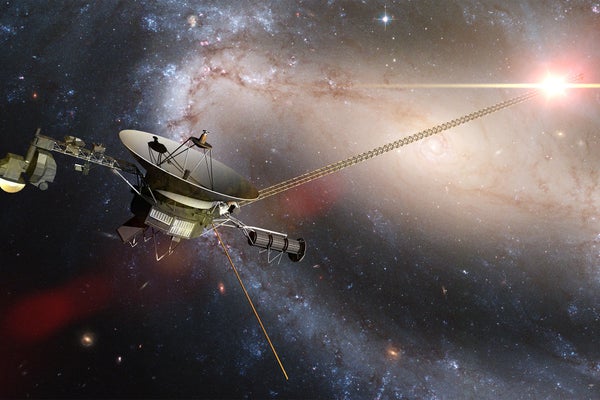
Artist's rendering of a Voyager spacecraft in deep space.
Dotted Zebra/Alamy Stock Photo
Amid April’s litany of bad news—war in Gaza, protests on American campuses, an impasse in Ukraine—a little uplift came for science buffs.
NASA has reestablished touch with Voyager 1 , the most distant thing built by our species, now hurtling through interstellar space far beyond the orbit of Pluto. The extraordinarily durable spacecraft had stopped transmitting data in November, but NASA engineers managed a very clever work-around, and it is sending data again. Now more than 15 billion miles away, Voyager 1 is the farthest human object, and continues to speed away from us at approximately 38,000 miles per hour.
Like an old car that continues to run, or an uncle blessed with an uncommonly long life, the robotic spacecraft is a super ager that goes on and on—and, in doing so, has captivated space buffs everywhere.
On supporting science journalism
If you're enjoying this article, consider supporting our award-winning journalism by subscribing . By purchasing a subscription you are helping to ensure the future of impactful stories about the discoveries and ideas shaping our world today.
Launched on September 5, 1977, the one-ton Voyager 1 was meant to chart the outer solar system, in particular the gas giant planets Jupiter and Saturn, and Saturn’s moon, Titan. Its twin, Voyager 2 , launched the same year, followed a different trajectory with a slightly different mission to explore the outer planets before heading to the solar system’s edge.
Those were NASA’s glory days. A few years earlier, NASA had successfully landed men on the moon—and won the space race for the U.S. NASA’s engineers were the envy of the world.
To get to Jupiter and Saturn, both Voyagers had to traverse the asteroid belt, which is full of rocks and debris orbiting the sun. They had to survive cosmic rays, intense radiation from Jupiter and other perils of space. But the two spacecraft made it without a hitch.
President Jimmy Carter held office when Voyager 1 was launched from Cape Canaveral; Elvis Presley had died just three weeks before; gas was about 60 cents a gallon; and, like now, the Middle East was in crisis, with Israeli Prime Minister Menachem Begin and Egyptian President Anwar Sadat trying to find peace.
Voyager 1 sent back spectacular photos of Jupiter and its giant red spot. It showed how dynamic the Jovian atmosphere was, with clouds and storms. It also took pictures of Jupiter’s moon Io, with its volcanoes, and Saturn’s moon Titan , which astronomers think has an atmosphere similar to the primordial Earth’s. The spacecraft discovered a thin ring around Jupiter and two new Jovian moons, which were named Thebe and Metis. On reaching Saturn, it discovered five new moons as well as a new ring.
And then Voyager 1 continued on its journey and sent images back from the edge of the solar system. Many of us remember the Pale Blue Dot , a haunting picture of the Earth it took on Feb 14, 1990, when it was a distance of 3.7 billion miles from the sun. The astronomer Carl Sagan wrote:
“There is perhaps no better demonstration of the folly of human conceits than this distant image of our tiny world. To me, it underscores our responsibility to deal more kindly with one another, and to preserve and cherish the pale blue dot, the only home we've ever known.”
By then Voyager 1 had long outlived its planetary mission but kept faithfully calling home as it traveled beyond the solar system into the realm of the stars. By 2012 Voyager 1 had reached the heliosphere , the farthest edge of the solar system. There, it penetrated the heliopause, where the solar wind ends, stopped by particles coming from the interstellar medium, the vast space between the stars. (Astronomers know that the space between the stars is not totally empty but permeated by a rarefied gas .)
From Voyager 1, scientists learned that the heliopause is quite dynamic and first measured the magnetic field of the Milky Way beyond the solar system. And its instruments kept sending data as it traveled through the interstellar medium.
On hearing that Voyager 1 had gone dark, I had checked in with Louis Lanzerotti , a former Bell Labs planetary scientist who did the calibrations for the Voyager 1 spacecraft and was a principal investigator on many experiments. He told me that a NASA manager in the 1970s had doubted that the spacecraft’s mechanical scan platform, which pointed instruments at targets, and very thin solid state detectors, which took those edge of the solar system readings, on the spacecraft would survive. They not only survived but worked flawlessly for all this time, Lanzerotti said, providing excellent data for decades. He was overjoyed on hearing the news that Voyager 1 was still alive.
Voyager 1 instruments have power until 2025 . After that, they will shut off, one by one. But there is nothing to stop the spacecraft as it speeds away from us in the vast emptiness of space.
Thousands of years from now, maybe when the human race has left this planet, Voyager 1, the tiny little spacecraft that could, will still continue its inexorable journey to the stars.
This is an opinion and analysis article, and the views expressed by the author or authors are not necessarily those of Scientific American.
Voyager 1: Facts about Earth's farthest spacecraft
Voyager 1 continues to explore the cosmos along with its twin probe, Voyager 2.
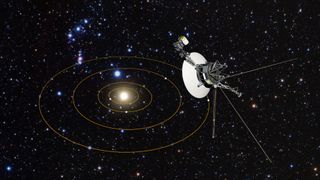
The Grand Tour
Voyager 1 jupiter flyby, voyager 1 visits saturn and its moons, voyager 1 enters interstellar space, voyager 1's interstellar adventures, additional resources.
Voyager 1 is the first spacecraft to travel beyond the solar system and reach interstellar space .
The probe launched on Sept. 5, 1977 — about two weeks after its twin Voyager 2 — and as of August 2022 is approximately 14.6 billion miles (23.5 billion kilometers) away from our planet, making it Earth 's farthest spacecraft. Voyager 1 is currently zipping through space at around 38,000 mph (17 kilometers per second), according to NASA Jet Propulsion Laboratory .
When Voyager 1 launched a mission to explore the outer planets in our solar system nobody knew how important the probe would still be 45 years later The probe has remained operational long past expectations and continues to send information about its journeys back to Earth.
Related: Celebrate 45 years of Voyager with these amazing images of our solar system (gallery)
Elizabeth Howell, Ph.D., is a staff writer in the spaceflight channel since 2022. She was contributing writer for Space.com for 10 years before that, since 2012. Elizabeth's on-site reporting includes two human spaceflight launches from Kazakhstan, three space shuttle missions in Florida, and embedded reporting from a simulated Mars mission in Utah.
Size: Voyager 1's body is about the size of a subcompact car. The boom for its magnetometer instrument extends 42.7 feet (13 meters). Weight (at launch): 1,797 pounds (815 kilograms). Launch date: Sept. 5, 1977
Jupiter flyby date: March 5, 1979
Saturn flyby date: Nov. 12, 1980.
Entered interstellar space: Aug. 25, 2012.
The spacecraft entered interstellar space in August 2012, almost 35 years after its voyage began. The discovery wasn't made official until 2013, however, when scientists had time to review the data sent back from Voyager 1.
Voyager 1 was the second of the twin spacecraft to launch, but it was the first to race by Jupiter and Saturn . The images Voyager 1 sent back have been used in schoolbooks and by many media outlets for a generation. The spacecraft also carries a special record — The Golden Record — that's designed to carry voices and music from Earth out into the cosmos.
According to NASA Jet Propulsion Laboratory (JPL) , Voyager 1 has enough fuel to keep its instruments running until at least 2025. By then, the spacecraft will be approximately 13.8 billion miles (22.1 billion kilometers) away from the sun.
The Voyager missions took advantage of a special alignment of the outer planets that happens just once every 176 years. This alignment allows spacecraft to gravitationally "slingshot" from one planet to the next, making the most efficient use of their limited fuel.
NASA originally planned to send two spacecraft past Jupiter, Saturn and Pluto and two other probes past Jupiter, Uranus and Neptune . Budgetary reasons forced the agency to scale back its plans, but NASA still got a lot out of the two Voyagers it launched.
Voyager 2 flew past Jupiter, Saturn, Uranus and Neptune , while Voyager 1 focused on Jupiter and Saturn.
Recognizing that the Voyagers would eventually fly to interstellar space, NASA authorized the production of two Golden Records to be placed on board the spacecraft. Sounds ranging from whale calls to the music of Chuck Berry were placed on board, as well as spoken greetings in 55 languages.
The 12-inch-wide (30 centimeters), gold-plated copper disks also included pictorials showing how to operate them and the position of the sun among nearby pulsars (a type of fast-spinning stellar corpse known as a neutron star ), in case extraterrestrials someday stumbled onto the spacecraft and wondered where they came from.
Both spacecraft are powered by three radioisotope thermoelectric generators , devices that convert the heat released by the radioactive decay of plutonium to electricity. Both probes were outfitted with 10 scientific instruments, including a two-camera imaging system, multiple spectrometers, a magnetometer and gear that detects low-energy charged particles and high-energy cosmic rays . Mission team members have also used the Voyagers' communications system to help them study planets and moons, bringing the total number of scientific investigations on each craft to 11.
Voyager 1 almost didn't get off the ground at its launch , as its rocket came within 3.5 seconds of running out of fuel on Sept. 5, 1977.
But the probe made it safely to space and raced past its twin after launch, getting beyond the main asteroid belt between Mars and Jupiter before Voyager 2 did. Voyager 1's first pictures of Jupiter beamed back to Earth in April 1978, when the probe was 165 million miles (266 million kilometers) from home.
According to NASA , each voyager probe has about 3 million times less memory than a mobile phone and transmits data approximately 38,000 times slower than a 5g internet connection.
To NASA's surprise, in March 1979 Voyager 1 spotted a thin ring circling the giant planet. It found two new moons as well — Thebe and Metis. Additionally, Voyager 1 sent back detailed pictures of Jupiter's big Galilean moons ( Io , Europa , Ganymede and Callisto ) as well as Amalthea .
Like the Pioneer spacecraft before it , Voyager's look at Jupiter's moons revealed them to be active worlds of their own. And Voyager 1 made some intriguing discoveries about these natural satellites. For example, Io's many volcanoes and mottled yellow-brown-orange surface showed that, like planets, moons can have active interiors.
Additionally, Voyager 1 sent back photos of Europa showing a relatively smooth surface broken up by lines, hinting at ice and maybe even an ocean underneath. (Subsequent observations and analyses have revealed that Europa likely harbors a huge subsurface ocean of liquid water, which may even be able to support Earth-like life .)
Voyager 1's closest approach to Jupiter was on March 5, 1979, when it came within 174,000 miles (280,000 km) of the turbulent cloud tops. Then it was time for the probe to aim for Saturn.
Scientists only had to wait about a year, until 1980, to get close-up pictures of Saturn. Like Jupiter, the ringed planet turned out to be full of surprises.
One of Voyager 1's targets was the F ring, a thin structure discovered only the year previously by NASA's Pioneer 11 probe. Voyager's higher-resolution camera spotted two new moons, Prometheus and Pandora, whose orbits keep the icy material in the F ring in a defined orbit. It also discovered Atlas and a new ring, the G ring, and took images of several other Saturn moons.
One puzzle for astronomers was Titan , the second-largest moon in the solar system (after Jupiter's Ganymede). Close-up pictures of Titan showed nothing but orange haze, leading to years of speculation about what it was like underneath. It wouldn't be until the mid-2000s that humanity would find out, thanks to photos snapped from beneath the haze by the European Space Agency's Huygens atmospheric probe .
The Saturn encounter marked the end of Voyager 1's primary mission. The focus then shifted to tracking the 1,590-pound (720 kg) craft as it sped toward interstellar space.
Two decades before it notched that milestone, however, Voyager 1 took one of the most iconic photos in spaceflight history. On Feb. 14, 1990, the probe turned back toward Earth and snapped an image of its home planet from 3.7 billion miles (6 billion km) away. The photo shows Earth as a tiny dot suspended in a ray of sunlight.
Voyager 1 took dozens of other photos that day, capturing five other planets and the sun in a multi-image "solar system family portrait." But the Pale Blue Dot picture stands out, reminding us that Earth is a small outpost of life in an incomprehensibly vast universe.
Voyager 1 left the heliosphere — the giant bubble of charged particles that the sun blows around itself — in August 2012, popping free into interstellar space. The discovery was made public in a study published in the journal Science the following year.
The results came to light after a powerful solar eruption was recorded by Voyager 1's plasma wave instrument between April 9 and May 22, 2013. The eruption caused electrons near Voyager 1 to vibrate. From the oscillations, researchers discovered that Voyager 1's surroundings had a higher density than what is found just inside the heliosphere.
It seems contradictory that electron density is higher in interstellar space than it is in the sun's neighborhood. But researchers explained that, at the edge of the heliosphere, the electron density is dramatically low compared with locations near Earth.
Researchers then backtracked through Voyager 1's data and nailed down the official departure date to Aug. 25, 2012. The date was fixed not only by the electron oscillations but also by the spacecraft's measurements of charged solar particles.
On that fateful day — which was the same day that Apollo 11 astronaut Neil Armstrong died — the probe saw a 1,000-fold drop in these particles and a 9% increase in galactic cosmic rays that come from outside the solar system . At that point, Voyager 1 was 11.25 billion miles (18.11 billion km) from the sun, or about 121 astronomical units (AU).
One AU is the average Earth-sun distance — about 93 million miles (150 million km).
You can keep tabs on the Voyager 1's current distance and mission status on this NASA website .
Since flying into interstellar space, Voyager 1 has sent back a variety of valuable information about conditions in this zone of the universe . Its discoveries include showing that cosmic radiation out there is very intense, and demonstrating how charged particles from the sun interact with those emitted by other stars , mission project scientist Ed Stone, of the California Institute of Technology in Pasadena, told Space.com in September 2017 .
The spacecraft's capabilities continue to astound engineers. In December 2017, for example, NASA announced that Voyager 1 successfully used its backup thrusters to orient itself to "talk" with Earth . The trajectory correction maneuver (TCM) thrusters hadn't been used since November 1980, during Voyager 1's flyby of Saturn. Since then, the spacecraft had primarily used its standard attitude-control thrusters to swing the spacecraft in the right orientation to communicate with Earth.
As the performance of the attitude-control thrusters began to deteriorate, however, NASA decided to test the TCM thrusters — an idea that could extend Voyager 1's operational life. That test ultimately succeeded.
"With these thrusters that are still functional after 37 years without use, we will be able to extend the life of the Voyager 1 spacecraft by two to three years," Voyager project manager Suzanne Dodd, of NASA's Jet Propulsion, Laboratory (JPL) in Southern California, said in a statement in December 2017 .
Mission team members have taken other measures to extend Voyager 1's life as well. For example, they turned off the spacecraft's cameras shortly after the Pale Blue Dot photo was taken to help conserve Voyager 1's limited power supply. (The cameras wouldn't pick up much in the darkness of deep space anyway.) Over the years, the mission team has turned off five other scientific instruments as well, leaving Voyager 1 with four that are still functioning — the Cosmic Ray Subsystem, the Low-Energy Charged Particles instrument, the Magnetometer and the Plasma Wave Subsystem. (Similar measures have been taken with Voyager 2, which currently has five operational instruments .)
The Voyager spacecraft each celebrated 45 years in space in 2022, a monumental milestone for the twin probes.
"Over the last 45 years, the Voyager missions have been integral in providing this knowledge and have helped change our understanding of the sun and its influence in ways no other spacecraft can," says Nicola Fox, director of the Heliophysics Division at NASA Headquarters in Washington, in a NASA statement .
"Today, as both Voyagers explore interstellar space, they are providing humanity with observations of uncharted territory," said Linda Spilker, Voyager's deputy project scientist at JPL in the same NASA statement.
"This is the first time we've been able to directly study how a star, our Sun, interacts with the particles and magnetic fields outside our heliosphere, helping scientists understand the local neighborhood between the stars, upending some of the theories about this region, and providing key information for future missions." Spilker continues.
Voyager 1's next big encounter will take place in 40,000 years when the probe comes within 1.7 light-years of the star AC +79 3888. (The star is roughly 17.5 light-years from Earth.) However, Voyager 1's falling power supply means it will probably stop collecting scientific data around 2025.
You can learn much more about both Voyagers' design, scientific instruments and mission goals at JPL's Voyager site . NASA has lots of in-depth information about the Pale Blue Dot photo, including Carl Sagan's large role in making it happen, here . And if you're interested in the Golden Record, check out this detailed New Yorker piece by Timothy Ferris, who produced the historic artifact. Explore the history of Voyager with this interactive timeline courtesy of NASA.
Bibliography
- Bell, Jim. " The Interstellar Age: Inside the Forty-Year Voyager Mission ," Dutton, 2015.
- Landau, Elizabeth. "The Voyagers in popular culture," Dec. 1, 2017. https://www.nasa.gov/feature/jpl/the-voyagers-in-popular-culture
- PBS, "Voyager: A history in photos." https://www.pbs.org/the-farthest/mission/voyager-history-photos/
Join our Space Forums to keep talking space on the latest missions, night sky and more! And if you have a news tip, correction or comment, let us know at: [email protected].
Get the Space.com Newsletter
Breaking space news, the latest updates on rocket launches, skywatching events and more!
Elizabeth Howell (she/her), Ph.D., is a staff writer in the spaceflight channel since 2022 covering diversity, education and gaming as well. She was contributing writer for Space.com for 10 years before joining full-time. Elizabeth's reporting includes multiple exclusives with the White House and Office of the Vice-President of the United States, an exclusive conversation with aspiring space tourist (and NSYNC bassist) Lance Bass, speaking several times with the International Space Station, witnessing five human spaceflight launches on two continents, flying parabolic, working inside a spacesuit, and participating in a simulated Mars mission. Her latest book, " Why Am I Taller ?", is co-written with astronaut Dave Williams. Elizabeth holds a Ph.D. and M.Sc. in Space Studies from the University of North Dakota, a Bachelor of Journalism from Canada's Carleton University and a Bachelor of History from Canada's Athabasca University. Elizabeth is also a post-secondary instructor in communications and science at several institutions since 2015; her experience includes developing and teaching an astronomy course at Canada's Algonquin College (with Indigenous content as well) to more than 1,000 students since 2020. Elizabeth first got interested in space after watching the movie Apollo 13 in 1996, and still wants to be an astronaut someday. Mastodon: https://qoto.org/@howellspace
- Daisy Dobrijevic Reference Editor
Japan to launch world's 1st wooden satellite in September
SpaceX targeting June 6 for next launch of Starship megarocket (photos)
SpaceX lands FAA license for Starship megarocket launch on June 6
Most Popular
- 2 'Venom: The Last Dance' gets 1st trailer full of alien symbiote mischief and mayhem (video)
- 3 Japan to launch world's 1st wooden satellite in September
- 4 China's Chang'e 6 probe launches samples of far side of the moon to lunar orbit. Next stop? Earth (photos)
- 5 Astrophotographer captures planetary parade with the moon in stunning photo
Things are finally looking up for the Voyager 1 interstellar spacecraft
Two of the four science instruments aboard the Voyager 1 spacecraft are now returning usable data after months of transmitting only gibberish, NASA scientists have announced.
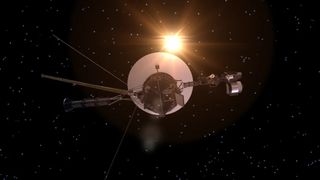
I was once sitting with my father while Googling how far away various things in the solar system are from Earth. He was looking for exact numbers, and very obviously grew more invested with each new figure I shouted out. I was thrilled. The moon? On average, 238,855 miles (384,400 kilometers) away. The James Webb Space Telescope ? Bump that up to about a million miles (1,609,344 km) away. The sun? 93 million miles (149,668,992 km) away. Neptune ? 2.8 billion miles (4.5 billion km) away. "Well, wait until you hear about Voyager 1," I eventually said, assuming he was aware of what was coming. He was not.
"NASA's Voyager 1 interstellar spacecraft actually isn't even in the solar system anymore," I announced. "Nope, it's more than 15 billion miles (24 billion km) away from us — and it's getting even farther as we speak." I can't quite remember his response, but I do indeed recall an expression of sheer disbelief. There were immediate inquiries about how that's even physically possible. There were bewildered laughs, different ways of saying "wow," and mostly, there was a contagious sense of awe. And just like that, a new Voyager 1 fan was born.
It is easy to see why Voyager 1 is among the most beloved robotic space explorers we have — and it is thus easy to understand why so many people felt a pang to their hearts several months ago, when Voyager 1 stopped talking to us.
Related: After months of sending gibberish to NASA, Voyager 1 is finally making sense again
For reasons unknown at the time, this spacecraft began sending back gibberish in place of the neatly organized and data-rich 0's and 1's it had been providing since its launch in 1977 . It was this classic computer language which allowed Voyager 1 to converse with its creators while earning the title of "farthest human made object." It's how the spacecraft relayed vital insight that led to the discovery of new Jovian moons and, thanks to this sort of binary podcast, scientists incredibly identified a new ring of Saturn and created the solar system's first and only "family portrait." This code, in essence, is crucial to Voyager 1's very being.
Plus, to make matters worse, the issue behind the glitch turned out to be associated with the craft's Flight Data System, which is literally the system that transmits information about Voyager 1's health so scientists can correct any issues that arise. Issues like this one. Furthermore, because of the spacecraft's immense distance from its operators on Earth, it takes about 22.5 hours for a transmission to reach the spacecraft, and then 22.5 hours to receive a transmission back. Alas, things weren't looking good for a while — for about five months, to be precise.
But then, on April 20, Voyager 1 finally phoned home with legible 0's and legible 1's.
Sign up for the Live Science daily newsletter now
Get the world’s most fascinating discoveries delivered straight to your inbox.
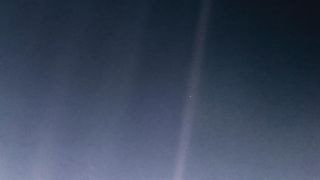
"The team had gathered early on a weekend morning to see whether telemetry would return," Bob Rasmussen, a member of the Voyager flight team, told Space.com. "It was nice to have everyone assembled in one place like this to share in the moment of learning that our efforts had been successful. Our cheer was both for the intrepid spacecraft and for the comradery that enabled its recovery."
And then, on May 22 , Voyager scientists released the welcome announcement that the spacecraft has successfully resumed returning science data from two of its four instruments, the plasma wave subsystem and magnetometer instrument. They're now working on getting the other two, the cosmic ray subsystem and low energy charged particle instrument, back online as well. Though there technically are six other instruments onboard Voyager, those had been out of commission for some time.
The comeback
Rasmussen was actually a member of the Voyager team in the 1970s, having worked on the project as a computer engineer before leaving for other missions including Cassini , which launched the spacecraft that taught us almost everything we currently know about Saturn. In 2022, however, he returned to Voyager because of a separate dilemma with the mission — and has remained on the team ever since.
"There are many of the original people who were there when Voyager launched, or even before, who were part of both the flight team and the science team," Linda Spilker, a planetary scientist at NASA's Jet Propulsion Laboratory , who also worked on the Voyager mission, told Space.com in the This Week from Space podcast on the TWiT network. "It's a real tribute to Voyager — the longevity not only of the spacecraft, but of the people on the team."
To get Voyager 1 back online, in rather cinematic fashion, the team devised a complex workaround that prompted the FDS to send a copy of its memory back to Earth. Within that memory readout, operators managed to discover the crux of the problem — a corrupted code spanning a single chip — which was then remedied through another (honestly, super interesting ) process to modify the code. On the day Voyager 1 finally spoke again, "you could have heard a pin drop in the room," Spilker said. "It was very silent. Everybody's looking at the screen, waiting and watching."
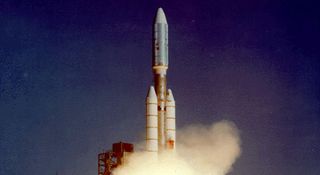
Of course, Spilker also brought in some peanuts for the team to munch on — but not just any peanuts. Lucky peanuts.
It's a longstanding tradition at JPL to have a peanut feast before major mission events like launches, milestones and, well, the possible resurrection of Voyager 1. It began in the 1960s, when the agency was trying to launch the Ranger 7 mission that was meant to take pictures of and collect data about the moon's surface. Rangers 1 through 6 had all failed, so Ranger 7 was a big deal. As such, the mission's trajectory engineer, Dick Wallace, brought lots of peanuts for the team to nibble on and relax. Sure enough, Ranger 7 was a success and, as Wallace once said, "the rest is history."
Voyager 1 needed some of those positive snacky vibes.
"It'd been five months since we'd had any information," Spilker explained. So, in this room of silence besides peanut-eating-noises, Voyager 1 operators sat at their respective system screens, waiting.
"All of a sudden it started to populate — the data," Spilker said. That's when the programmers who had been staring at those screens in anticipation leapt out of their seats and began to cheer: "They were the happiest people in the room, I think, and there was just a sense of joy that we had Voyager 1 back."

Eventually, Rasmussen says the team was able to conclude that the failure probably occurred due to a combination of aging and radiation damage by which energetic particles in space bombarded the craft. This is also why he believes it wouldn't be terribly surprising to see a similar failure occur in the future, seeing as Voyager 1 is still roaming beyond the distant boundaries of our stellar neighborhood just like its spacecraft twin, Voyager 2 .
To be sure, the spacecraft isn't fully fixed yet — but it's lovely to know things are finally looking up, especially with the recent news that some of its science instruments are back on track. And, at the very least, Rasmussen assures that nothing the team has learned so far has been alarming. "We're confident that we understand the problem well," he said, "and we remain optimistic about getting everything back to normal — but we also expect this won't be the last."

In fact, as Rasmussen explains, Voyager 1 operators first became optimistic about the situation just after the root cause of the glitch had been determined with certainty. He also emphasizes that the team's spirits were never down. "We knew from indirect evidence that we had a spacecraft that was mostly healthy," he said. "Saying goodbye was not on our minds."
"Rather," he continued, "we wanted to push toward a solution as quickly as possible so other matters on board that had been neglected for months could be addressed. We're now calmly moving toward that goal."
The future of Voyager's voyage
It can't be ignored that, over the last few months, there has been an air of anxiety and fear across the public sphere that Voyager 1 was slowly moving toward sending us its final 0 and final 1. Headlines all over the internet, one written by myself included , have carried clear, negative weight. I think it's because even if Voyager 2 could technically carry the interstellar torch post-Voyager 1, the prospect of losing Voyager 1 felt like the prospect of losing a piece of history.
"We've crossed this boundary called the heliopause," Spilker explained of the Voyagers. "Voyager 1 crossed this boundary in 2012; Voyager 2 crossed it in 2018 — and, since that time, were the first spacecraft ever to make direct measurements of the interstellar medium." That medium basically refers to material that fills the space between stars. In this case, that's the space between other stars and our sun, which, though we don't always think of it as one, is simply another star in the universe. A drop in the cosmic ocean.
"JPL started building the two Voyager spacecraft in 1972," Spilker explained. "For context, that was only three years after we had the first human walk on the moon — and the reason we started that early is that we had this rare alignment of the planets that happens once every 176 years ." It was this alignment that could promise the spacecraft checkpoints across the solar system, including at Jupiter, Saturn, Uranus and Neptune. Those checkpoints were important for the Voyagers in particular. Alongside planetary visits come gravity assists, and gravity assists can help fling stuff within the solar system — and, now we know, beyond.
As the first humanmade object to leave the solar system, as a relic of America's early space program, and as a testament to how robust even decades-old technology can be, Voyager 1 has carved out the kind of legacy usually reserved for remarkable things lost to time.

"Our scientists are eager to see what they’ve been missing," Rasmussen remarked. "Everyone on the team is self-motivated by their commitment to this unique and important project. That's where the real pressure comes from."
Still, in terms of energy, the team's approach has been clinical and determined.
— NASA's Voyager 1 sends readable message to Earth after 4 nail-biting months of gibberish
— NASA engineers discover why Voyager 1 is sending a stream of gibberish from outside our solar system
— NASA's Voyager 1 probe hasn't 'spoken' in 3 months and needs a 'miracle' to save it
"No one was ever especially excited or depressed," he said. "We're confident that we can get back to business as usual soon, but we also know that we're dealing with an aging spacecraft that is bound to have trouble again in the future. That's just a fact of life on this mission, so not worth getting worked up about."
Nonetheless, I imagine it's always a delight for Voyager 1's engineers to remember this robotic explorer occupies curious minds around the globe. (Including my dad's mind now, thanks to me and Google.)
As Rasmussen puts it: "It's wonderful to know how much the world appreciates this mission."
Originally posted on Space.com .
Monisha Ravisetti is Space.com's Astronomy Editor. She covers black holes, star explosions, gravitational waves, exoplanet discoveries and other enigmas hidden across the fabric of space and time. Previously, she was a science writer at CNET, and before that, reported for The Academic Times. Prior to becoming a writer, she was an immunology researcher at Weill Cornell Medical Center in New York. She graduated from New York University in 2018 with a B.A. in philosophy, physics and chemistry. She spends too much time playing online chess. Her favorite planet is Earth.
China's secret space plane has released another unknown object over Earth
NASA details plan to build a levitating robot train on the moon
Black hole 'morsels' could finally prove Stephen Hawking's famous theory right
Most Popular
- 2 Space photo of the week: James Webb telescope spots galaxy churning out stars in overtime
- 3 How people without 'inner voices' could help reveal the mysteries of consciousness
- 4 Auroras could paint Earth's skies again in early June. Here are the key nights to watch for.
- 5 32 of the loudest animals on Earth
- 2 GPT-4 didn't ace the bar exam after all, MIT research suggests — it didn't even break the 70th percentile
- 3 The brain can store nearly 10 times more data than previously thought, study confirms
- 4 Viking sword with 'very rare' inscription discovered on family farm in Norway
- 5 'She is so old': One-eyed wolf in Yellowstone defies odds by having 10th litter of pups in 11 years

The Pale Blue Dot – Revisited

The Pale Blue Dot is a photograph of Earth taken Feb. 14, 1990, by NASA’s Voyager 1 at a distance of 3.7 billion miles (6 billion kilometers) from the Sun. The image inspired the title of scientist Carl Sagan's book, "Pale Blue Dot: A Vision of the Human Future in Space," in which he wrote: "Look again at that dot. That's here. That's home. That's us."
The revised image was processed by JPL engineer and image processing enthusiast Kevin M. Gill with input from two of the image's original planners, Candy Hansen and William Kosmann.
Original – Highest-Resolution (1990)
(tif) (4.32 MB)
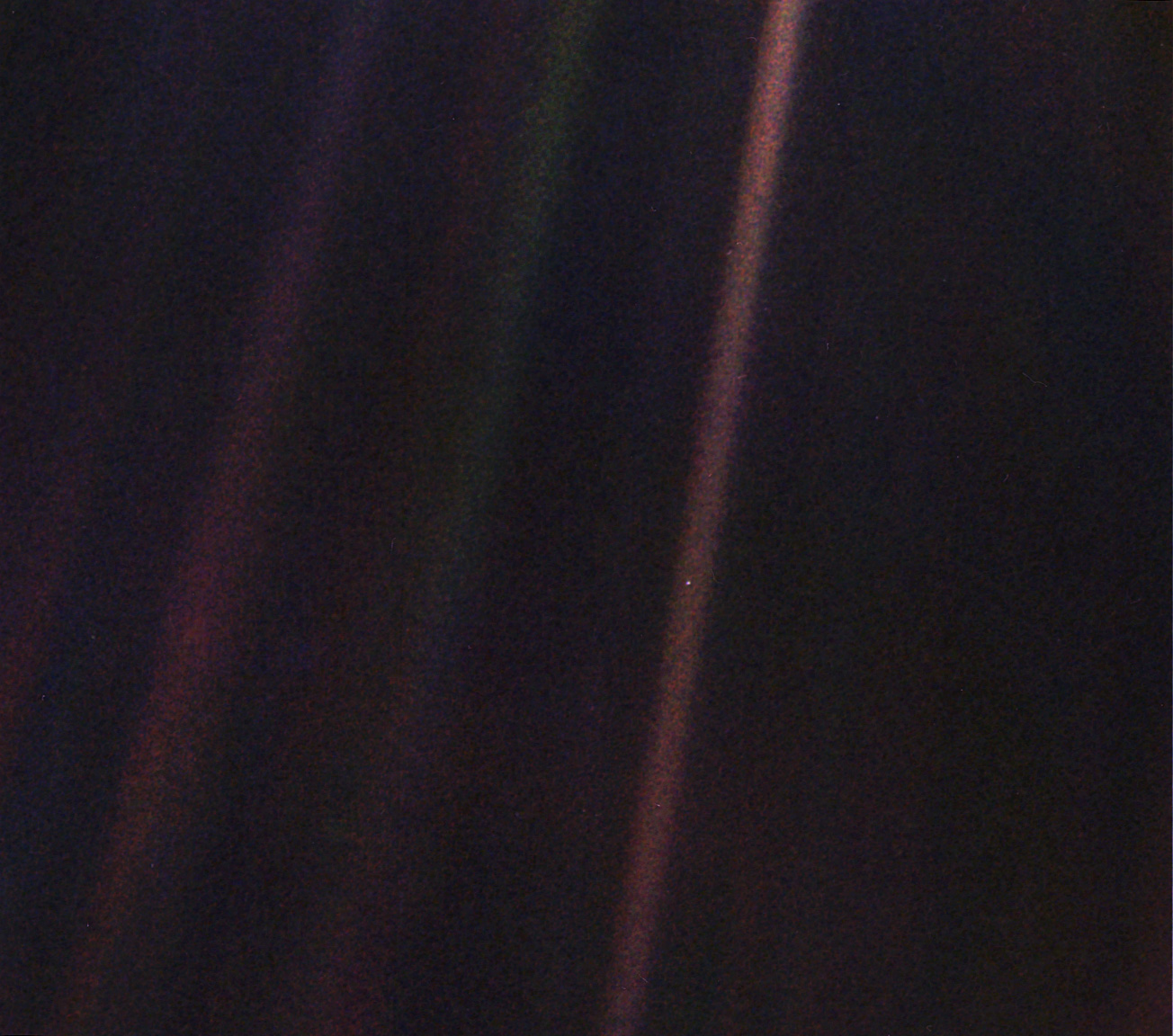
Original (1990)
(jpg) (414.21 KB)
Pale Blue Dot Revisited (2020)
(tif) (29.85 MB)

- The Contents
- The Making of
- Where Are They Now
- Frequently Asked Questions
- Q & A with Ed Stone
golden record
Where are they now.
- frequently asked questions
- Q&A with Ed Stone
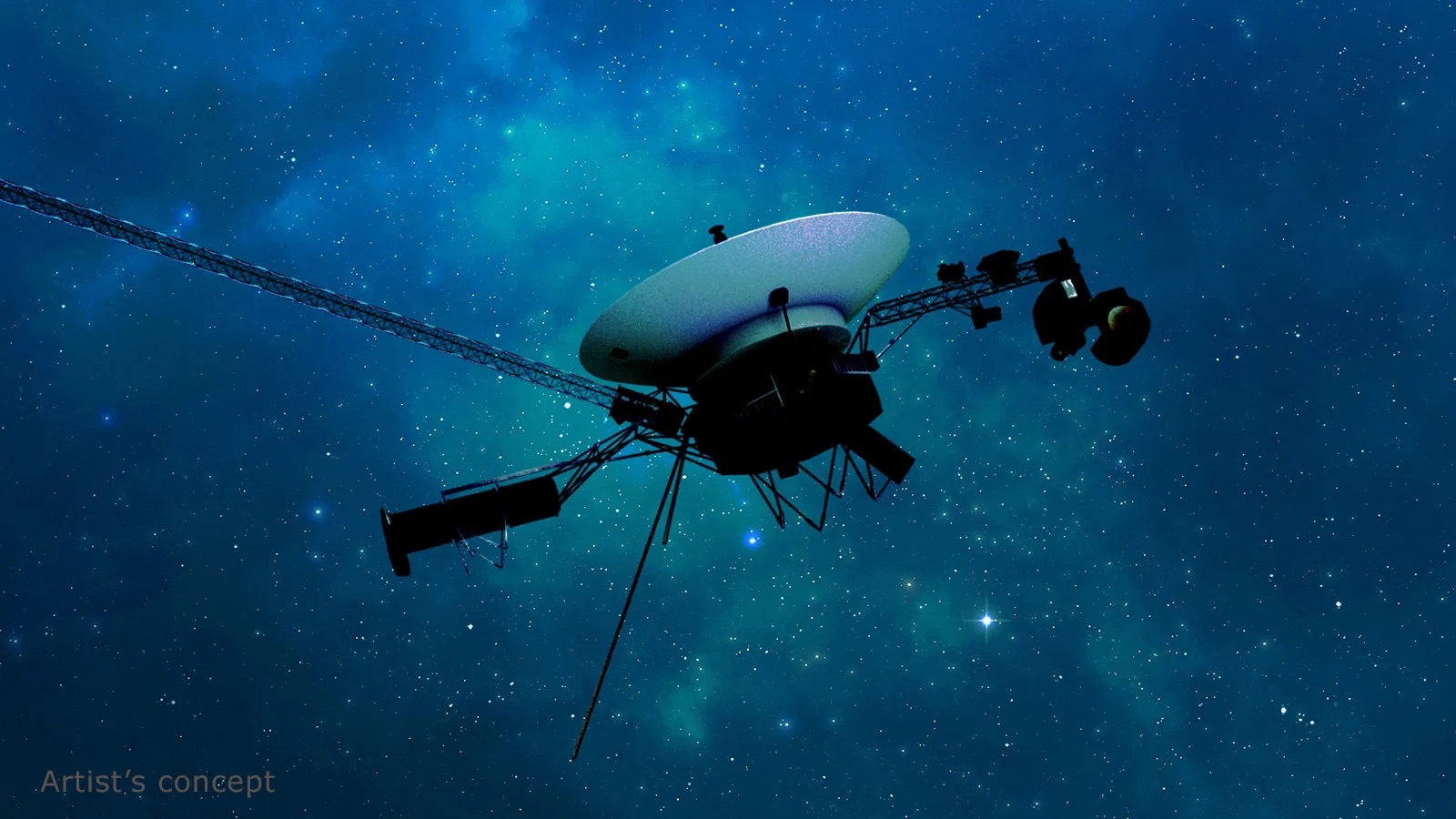
NASA’s Voyager Team Focuses on Software Patch, Thrusters

NASA Mission Update: Voyager 2 Communications Pause
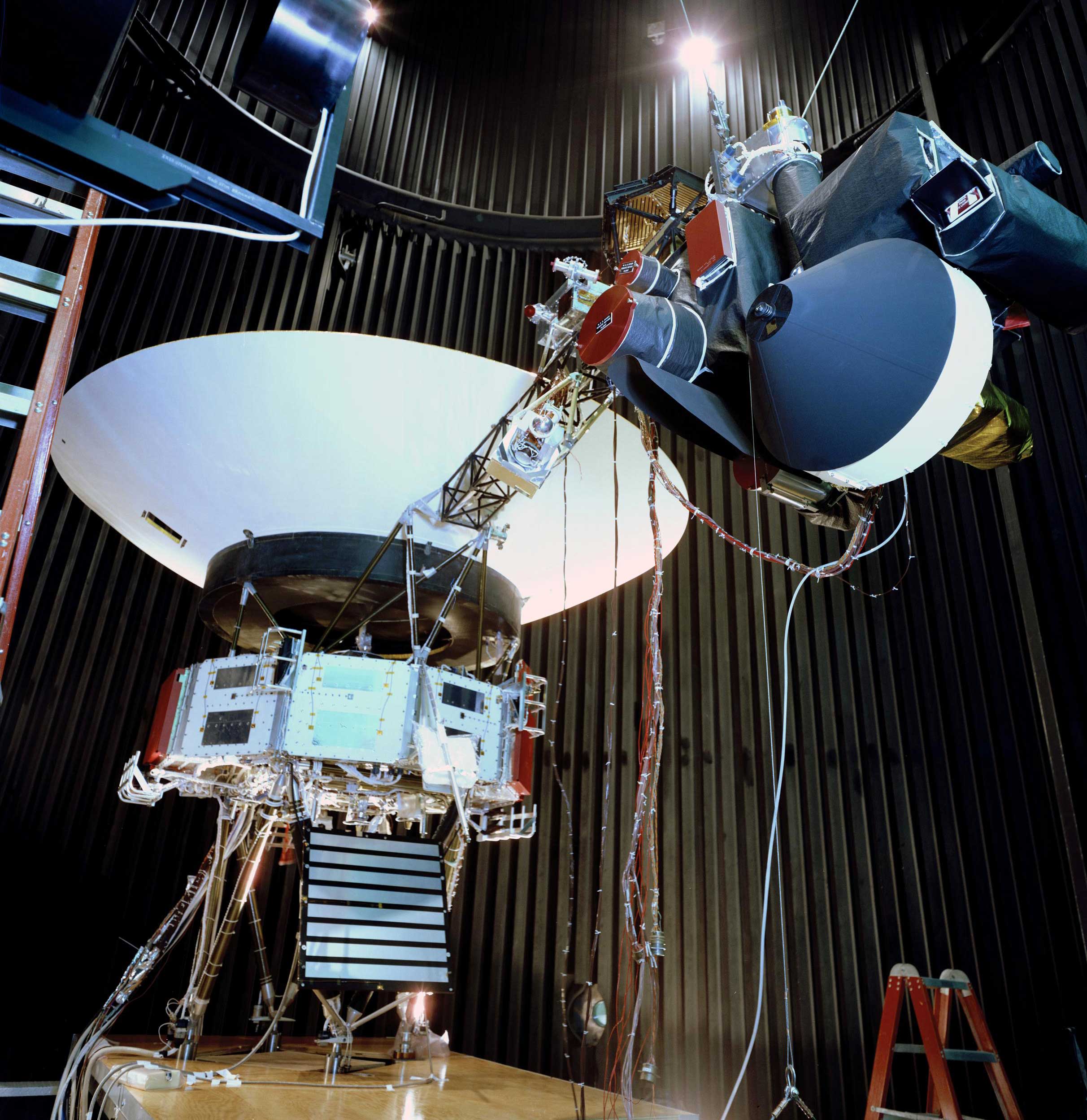
NASA's Voyager Will Do More Science With New Power Strategy
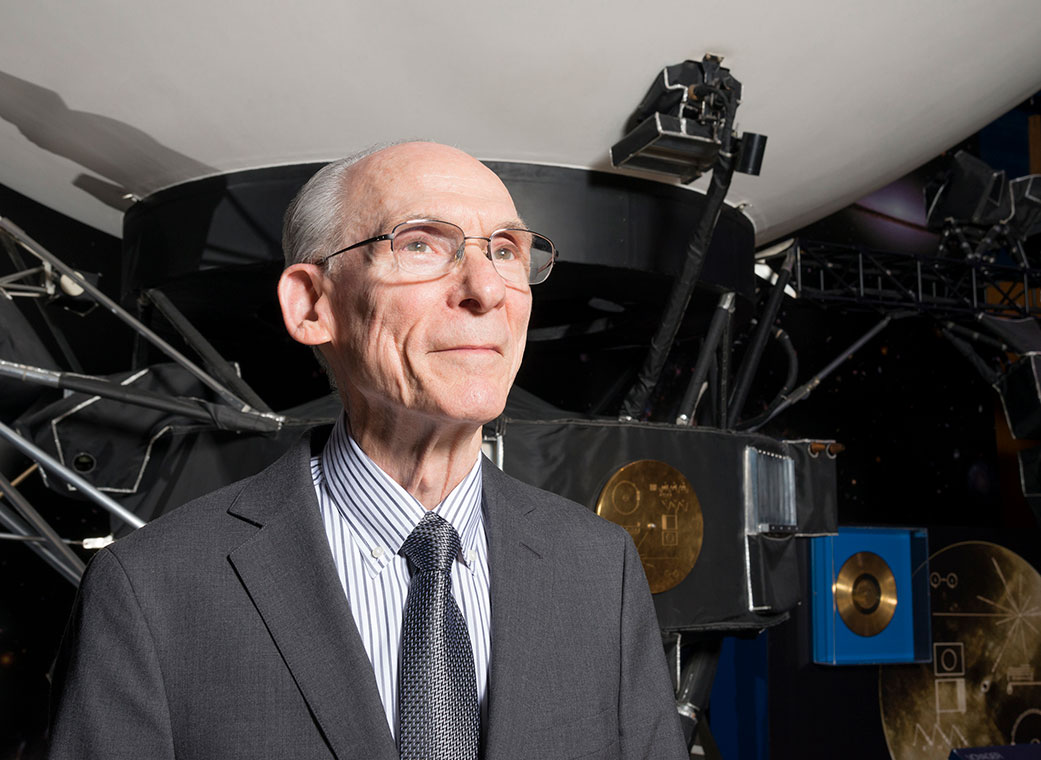
Edward Stone Retires After 50 Years as NASA Voyager's Project Scientist
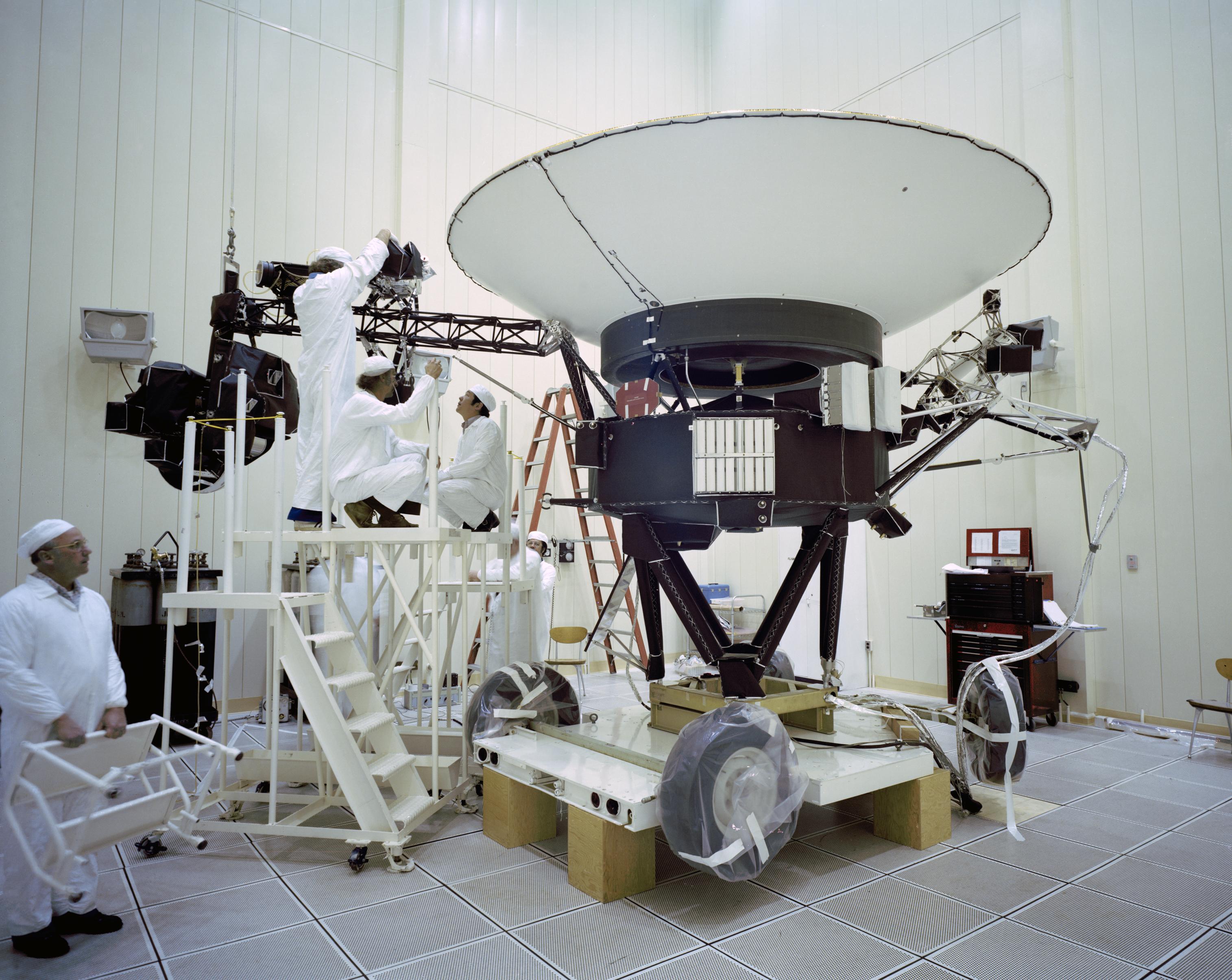
Voyager, NASA's Longest-Lived Mission, Logs 45 Years in Space
Voyager 1 distance from earth, voyager 1 distance from sun, voyager 1 one-way light time, voyager 1 cosmic ray data, voyager 2 distance from the earth, voyager 2 distance from the sun, voyager 2 one-way light time, voyager 2 cosmic ray data, what's happening now.
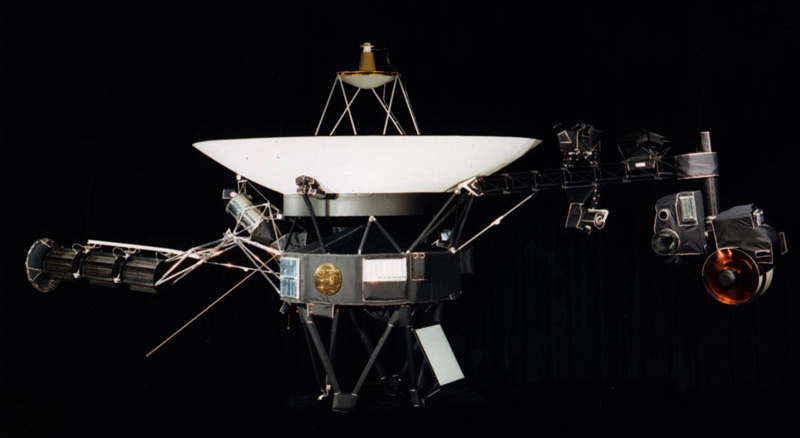
Voyager 1 has resumed returning science data from two of its four instruments for the first time since a computer issue arose with the spacecraft in November 2023.
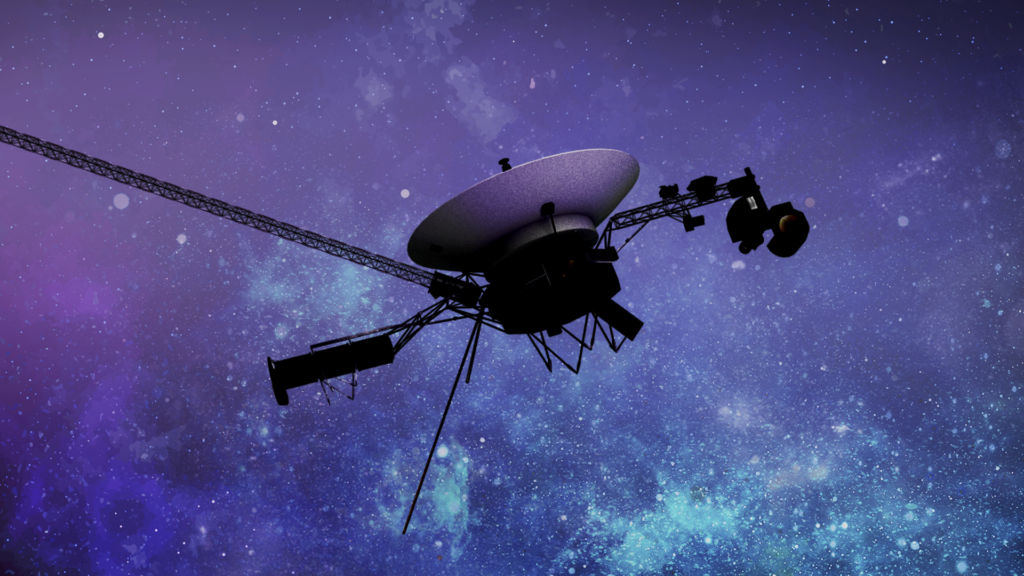
Since November 2023, NASA’s Voyager 1 spacecraft has been sending a steady radio signal to Earth, but the signal does not contain usable data.
Engineers are working to resolve an issue with one of Voyager 1’s three onboard computers, called the flight data system (FDS).

Download the Voyager 40th Anniversary posters.
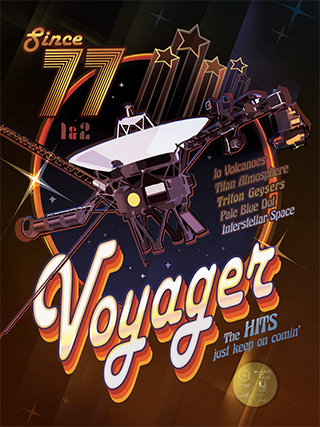
14.6 billion miles away, NASA gets Voyager 1 talking again — and discovers a new mystery
That’s some repair job.
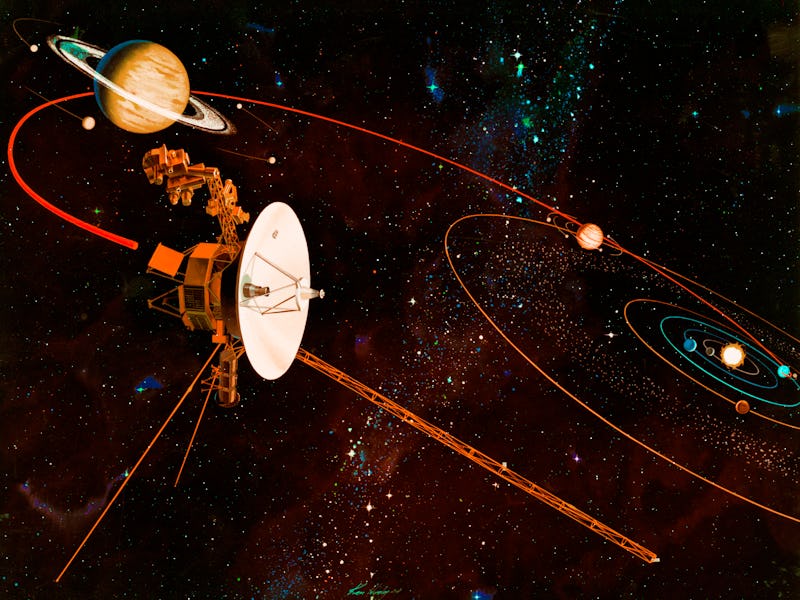
NASA’s Voyager 1 is on a fraught and unknowable journey into deep space. Some 14.6 billion miles from Earth, it and its sister craft, Voyager 2, are the furthest human-made objects from our planet, having made it beyond the edges of the Solar System and out into the interstellar medium. At such distances, anything can go wrong. Add to that the fact that these are old craft: The Voyagers launched in the 1970s. So when Voyager 1 started to send home weird, garbled nonsense instead of telemetry data in May of this year , NASA engineers might have been forgiven for calling it a day and pouring one out for perhaps the most successful space mission of all time.
But that’s not how NASA works . Instead, they started working on a remote diagnosis and fix for the record-breaking spacecraft. Now, some four months later, they are triumphant. Voyager 1 is back online and communicating perfectly with ground control as if it never happened. In fact, the fix turned out to be relatively simple — or as simple as anything can be with a 22-hour communications lag in each direction and billions of miles of space in between.
What happened to Voyager 1?
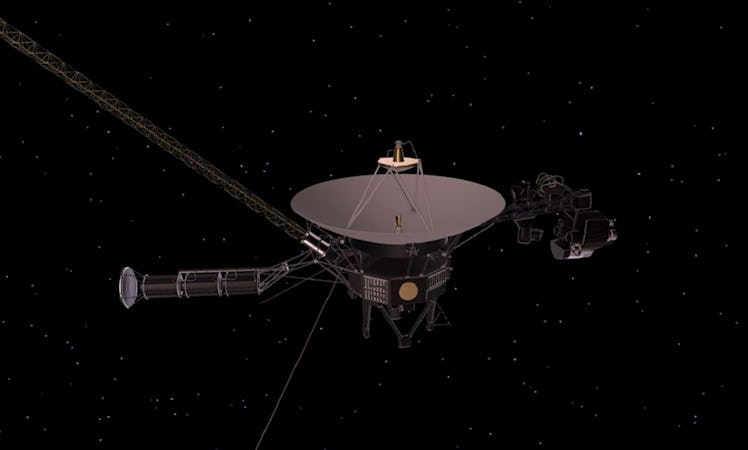
The high-gain antenna, shown on the left in this illustration, is how Voyager 1 sends and receives radio communications with NASA engineers here on Earth.
Cruising in interstellar space, the 45-year-old spacecraft appeared to be operating shockingly well and was transmitting reams of data back to Earth. But in mid-May, Voyager 1’s onboard system responsible for keeping its high-gain antenna pointed at Earth, known as the attitude articulation and control system, or AACS, started beaming home confusing jumbles of data instead of the usual reports about the spacecraft’s health and status. From our viewpoint, it appeared as if the spacecraft had developed something like an electronic version of aphasia — a condition that causes the loss of fluent speech.
“The data may appear to be randomly generated, or does not reflect any possible state the AACS could be in,” explained NASA in a statement from the time.
Even more bafflingly for engineers, Voyager 1 appeared to be in perfect condition despite the spacecraft’s bizarre status reports. The radio signal from the ship remained strong and steady, which meant the antenna was still pointed at Earth — and not in whatever configuration the AACS was claiming it was in to NASA in the reports. Similarly, Voyager 1’s science systems kept gathering and transmitting data as usual, without any of the same strangeness affecting the AACS. And, whatever was wrong with the AACS didn’t trip a fault protection system designed to put the spacecraft in safe mode when there’s a glitch.
Thankfully, NASA engineers diagnosed the problem. And with the diagnosis, they could employ a cure.
The fix — It turned out that the AACS had started sending its telemetry data via an onboard computer that had stopped working years ago. The dead computer corrupted all the outgoing data. All NASA engineers had to do was send the command to the AACS to use the correct computer to send its data home.
But there’s still a problem — The next challenge will be to figure out exactly what caused the AACS to switch computers in the first place. NASA says the system probably received a faulty command from another onboard computer. While they say it is not a major concern for Voyager 1’s well-being right now, the true culprit will need to be found and fixed to prevent future weirdness.
Voyager 1 lives on
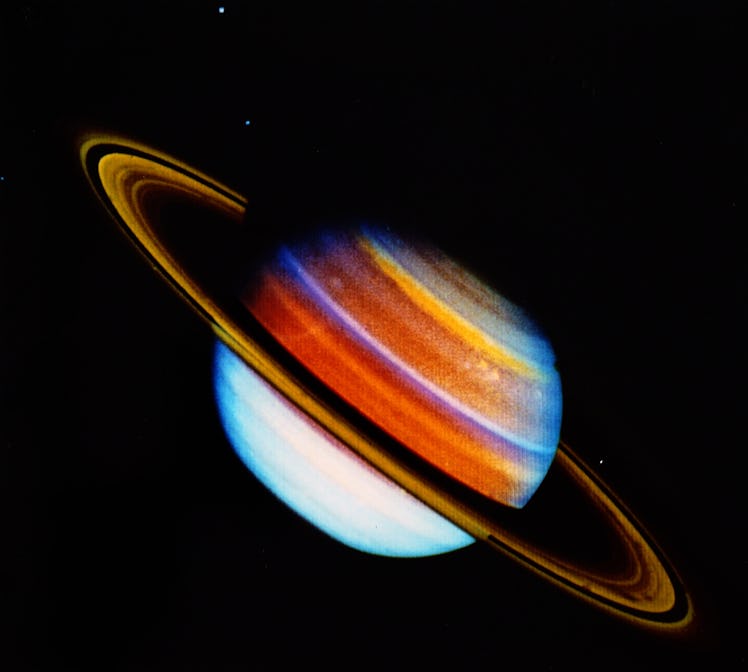
Voyager 1 has yielded revelations about our Solar System no one could have predicted.
Currently, Voyager 1 is more than 23.4 billion kilometers or 14.6 billion miles (and gaining, most of the time ) from Earth. You can watch the distance grow and see both Voyager spacecraft’s current positions in space on NASA’s website .
For the last decade, Voyager 1 has been cruising in interstellar space, beyond the reach of our Sun’s magnetic field. The field had offered the craft a little protection from cosmic rays and other interstellar radiation, much as Earth’s magnetic field offers some protection from high-energy particles and radiation from the Sun. Cosmic rays are known to interfere with electronics here on Earth — when one of those high-speed energetic particles strikes a computer chip, it can cause small memory errors, which add up over time — and it’s reasonable to expect that to be an issue for Voyager 1’s onboard computers, too.
“A mystery like this is sort of par for the course at this stage of the Voyager mission,” said Voyager 1 and 2 project manager Suzanne Dodd in a statement dated to May.
“The spacecraft are both almost 45 years old, which is far beyond what the mission planners anticipated. We’re also in interstellar space — a high-radiation environment that no spacecraft have flown in before.”
We’ll need to wait and see what new perils encounter Voyager next on its travels — and what new discoveries await.
Subscribe for free to Inverse’s award-winning daily newsletter.
This article was originally published on Aug. 31, 2022
- Space Science

IMAGES
VIDEO
COMMENTS
Galleries of Images Voyager Took. The Voyager 1 and 2 spacecraft explored Jupiter, Saturn, Uranus and Neptune before starting their journey toward interstellar space. Here you'll find some of those iconic images, including "The Pale Blue Dot" - famously described by Carl Sagan - and what are still the only up-close images of Uranus and Neptune.
Here are 18 groundbreaking photos from their incredible mission. This montage shows examples of striking images of the solar system Voyager 1 and 2 took on their missions. NASA/JPL/Insider. Nearly ...
Voyager 1 and Voyager 2 have traveled deeper into space than any other manmade object, making them the most distant cameras in the universe. ... Here Are Their Best Space Photos. Jun 22, 2022.
Both Voyager 1 and Voyager 2 have reached "Interstellar space" and each continue their unique journey through the Universe. In the NASA Eyes on the Solar System app, you can see the real spacecraft trajectories of the Voyagers, which are updated every five minutes. ... 2022 Tracking Schedule 22_01_06-22_01_24 22_01_13-22_01_31 22_01_20-22_02_07 ...
Images Voyager Took. The Voyager 1 and 2 spacecraft explored Jupiter, Saturn, Uranus and Neptune before starting their journey toward interstellar space. Here you'll find some of those iconic images, including "The Pale Blue Dot" - famously described by Carl Sagan - and what are still the only up-close images of Uranus and Neptune.
This photo of Jupiter was taken by NASA's Voyager 1 on the evening of March 1, 1979, from a distance of 2.7 million miles (4.3 million kilometers). ... This updated version of the iconic "Pale Blue Dot" image taken by the Voyager 1 spacecraft uses modern image-processing software and techniques to revisit the well-known Voyager view while ...
Voyager 1 is a space probe launched by NASA on ... 2022-07-14 Voyager 1 has reached a distance of 23 ... made under the direction of a team including Carl Sagan and Timothy Ferris, includes photos of the Earth and its lifeforms, a range of scientific information, spoken greetings from people such as the Secretary-General of the United ...
On Feb. 14, 1990, NASA's Voyager 1 probe snapped a photo of Earth from 3.7 billion miles (6 billion kilometers) away. The image shows our home planet as it truly is — a tiny, lonely outpost of ...
Image: NASA / JPL / Ted Stryk. Saturn as seen by Voyager 1 The last picture from Voyager 1's approach to Saturn in which the entire planet and ring system can be seen in a single frame. Image: NASA/JPL/Björn Jónsson. Voyager 2's best view of Enceladus This was the Voyager mission's best view of Enceladus, captured by Voyager 2 on August 26 ...
This image of the Earth and moon are in a single frame. Voyager was the first spacecraft to achieve this and captured the iconic image on Sept. 18, 1977, by Voyager 1 when it was 7.25 million ...
And on July 9, 2022, as part of a test of its new capabilities, it was able to to seek and detect Voyager 1's carrier signal. Wael Farah is a radio scientist for SETI.
Solar System Portrait. This narrow-angle color image of the Earth, dubbed 'Pale Blue Dot', is a part of the first ever 'portrait' of the solar system taken by Voyager 1. The spacecraft acquired a total of 60 frames for a mosaic of the solar system from a distance of more than 4 billion miles from Earth and about 32 degrees above the ecliptic.
Voyager 1 sent back spectacular photos of Jupiter and its giant red spot. It showed how dynamic the Jovian atmosphere was, with clouds and storms. It also took pictures of Jupiter's moon Io ...
Voyager 1 has been exploring our solar system since 1977. The probe is now in interstellar space, the region outside the heliopause, or the bubble of energetic particles and magnetic fields from the Sun. Voyager 1 was launched after Voyager 2, but because of a faster route it exited the asteroid belt earlier than its twin, and it overtook Voyager 2 on Dec. 15, 1977.
The probe launched on Sept. 5, 1977 — about two weeks after its twin Voyager 2 — and as of August 2022 is approximately 14.6 billion miles ... Voyager 1 took dozens of other photos that day ...
In 2022, however, he returned to Voyager because of a separate dilemma with the mission — and has remained on the team ever since. ... "Voyager 1 crossed this boundary in 2012; Voyager 2 crossed ...
October 25, 2022. Edward Stone Retires After 50 Years as NASA Voyager's Project Scientist ... Voyager 1, already the most distant human-made object in the cosmos, reaches 100 astronomical units from the sun on Tuesday. That means the spacecraft, which launched three decades ago, will be 100 times more distant from the sun than Earth is. May 23 ...
The Pale Blue Dot - Revisited. The Pale Blue Dot is a photograph of Earth taken Feb. 14, 1990, by NASA's Voyager 1 at a distance of 3.7 billion miles (6 billion kilometers) from the Sun. The image inspired the title of scientist Carl Sagan's book, "Pale Blue Dot: A Vision of the Human Future in Space," in which he wrote: "Look again at that ...
Here is the 1st-ever photo of the Earth and moon in a single frame. Voyager 1 took the photo on September 18, 1977, when it was 7.25 million miles (11.66 million km) from Earth. ... 2022, Voyager ...
This is a real-time indicator of Voyager 1's distance from Earth in astronomical units (AU) and either miles (mi) or kilometers (km). Note: Because Earth moves around the sun faster than Voyager 1 is speeding away from the inner solar system, the distance between Earth and the spacecraft actually decreases at certain times of year.
Voyager 1 has yielded revelations about our Solar System no one could have predicted. Currently, Voyager 1 is more than 23.4 billion kilometers or 14.6 billion miles (and gaining, most of the time ...